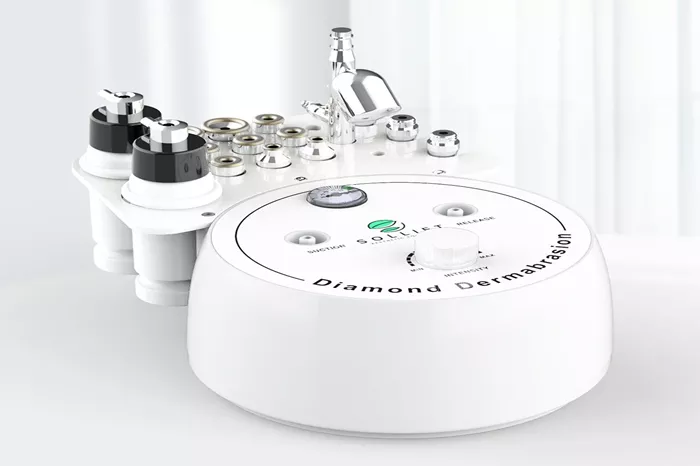In the pursuit of youthful and radiant skin, diamond microdermabrasion has emerged as a popular non-invasive cosmetic procedure. This technique uses a handheld device with a diamond-tipped head to exfoliate and rejuvenate the skin. Unlike crystal-based systems, diamond microdermabrasion offers precise control and effectiveness, making it suitable for various skin types and concerns. Whether you’re a skincare professional or an enthusiast looking to enhance your skin’s texture and appearance, understanding how to use a diamond microdermabrasion machine effectively is essential.
Understanding Diamond Microdermabrasion
Diamond microdermabrasion works on the principle of exfoliation, where a diamond-tipped wand gently removes dead skin cells from the epidermis. This process stimulates cell turnover and collagen production, leading to smoother, softer skin with improved texture and tone. Unlike traditional microdermabrasion methods that use crystals, diamond-tipped machines provide more precision and are less messy, making them preferable for both practitioners and clients.
Benefits of Diamond Microdermabrasion:
Exfoliation: Removes dead skin cells.
Improves Skin Texture: Smoothens rough patches and acne scars.
Enhances Product Absorption: Allows skincare products to penetrate deeper.
Stimulates Collagen Production: Promotes skin elasticity and firmness.
Reduces Fine Lines and Wrinkles: Improves overall skin appearance.
Preparing for a Diamond Microdermabrasion Treatment
Before starting a diamond microdermabrasion session, thorough preparation ensures optimal results and client safety. Follow these steps to prepare:
1. Consultation and Skin Analysis
Begin with a consultation to assess the client’s skin type, concerns, and medical history. Conduct a skin analysis to identify areas that require attention and determine the appropriate diamond tip and suction level.
2. Pre-treatment Skin Preparation
Ensure the client’s skin is clean and free of makeup, oils, or moisturizers. Use a gentle cleanser to remove impurities and pat dry with a clean towel. This step prevents any residue from interfering with the microdermabrasion process.
3. Protecting Sensitive Areas
Apply a barrier cream or petroleum jelly to sensitive areas such as the eyes, lips, and nostrils to prevent irritation or abrasion during the treatment. Provide eye protection goggles to shield the eyes from stray diamond particles.
4. Adjusting the Machine Settings
Set the diamond microdermabrasion machine to the appropriate suction level and choose the diamond tip size based on the client’s skin type and sensitivity. Start with a lower suction setting for sensitive skin and gradually increase as needed.
See also: How Does Neutrogena Microdermabrasion Work?
Performing Diamond Microdermabrasion
Mastering the technique of diamond microdermabrasion requires precision and skill to achieve optimal results while ensuring client comfort and safety.
1. Technique and Motion
Hold the diamond-tipped wand at a 45-degree angle to the skin and gently glide it across the treatment area in short, overlapping strokes. Maintain constant but gentle pressure to ensure effective exfoliation without causing discomfort or injury.
2. Treatment Areas
Focus on one area at a time, starting from the forehead and moving downwards to the cheeks, nose, chin, and neck. Adjust the diamond tip size and suction strength as you transition between different areas of the face and body.
3. Pay Attention to Detail
Pay special attention to areas with acne scars, fine lines, or hyperpigmentation, adjusting the wand’s speed and pressure to target specific skin concerns effectively. Use a mirror or magnifying lamp to ensure thorough treatment coverage.
4. Post-treatment Care
After completing the diamond microdermabrasion session, provide post-care instructions to the client. Apply a soothing mask or serum to hydrate and calm the skin, followed by a moisturizer with SPF protection to shield against UV damage.
Advanced Techniques and Tips
To elevate your diamond microdermabrasion skills, consider incorporating advanced techniques and tips:
Combination Therapies: Combine microdermabrasion with other treatments like chemical peels or LED therapy for enhanced results.
Customized Treatments: Tailor treatments by adjusting suction levels, diamond tip sizes, and treatment durations based on individual client needs.
Regular Maintenance: Recommend a series of sessions spaced several weeks apart for optimal results, followed by maintenance treatments to sustain skin improvements.
Troubleshooting Common Issues
Address common challenges encountered during diamond microdermabrasion treatments:
Redness or Irritation: Lower suction levels and shorten treatment duration for sensitive skin types.
Uneven Exfoliation: Ensure even pressure and overlapping strokes to achieve uniform exfoliation.
Post-treatment Breakouts: Recommend gentle skincare products and avoid heavy makeup immediately after treatment.
Conclusion
Diamond microdermabrasion offers a safe and effective solution for achieving smoother, more youthful-looking skin without downtime or discomfort. By mastering the art of diamond microdermabrasion, skincare professionals can cater to diverse client needs while delivering noticeable improvements in skin texture and appearance. With proper technique, personalized treatment plans, and attention to detail, diamond microdermabrasion remains a valuable tool in the realm of non-invasive skincare treatments.
Incorporate these guidelines into your practice to unlock the full potential of diamond microdermabrasion and empower clients to achieve their skincare goals with confidence and satisfaction.
Related topics:
7 Steps To Using Neutrogena Microdermabrasion
Will 1 microdermabrasion work?
How do I get the best results from microdermabrasion?


